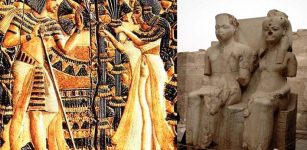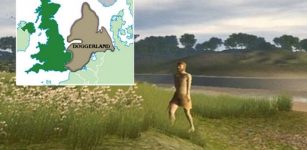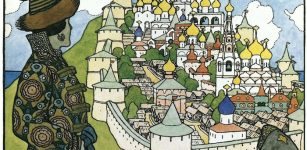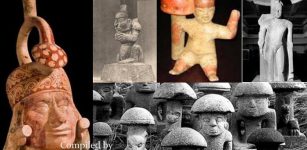Ancient Irish Games Hurling And Curling Were Forbidden In 1366 By The Englishmen
AncientPages.com - During the Anglo-Norman invasion of Ireland that took place in stages throughout the late 12th century, the Englishmen did their best to prevent their colonizers to become too Irish.
There was a distinct difference between who was considered "mere" Irish and the Anglo-Irish colonizers. One way of avoiding confusion between these two groups was to prohibit participation in certain ancient traditions and sports.
Hurling and curling were two ancient Irish games that were very popular and were forbidden in 1366, as stated in the Statutes of Kilkenny.
The English had difficulty in taking over Ireland. The first English settlers, the Anglo-Irish, began to become Irish in the way the viewed the world. They began to put their own interests ahead of those of the English royalty.
These problems led to the creation of the Statutes of Kilkenny that were a set of laws made by the English in 1367 to try and save the English colony in Ireland. The laws were made by the Lord Lieutenant of Ireland, Lionel of Antwerp, 1st Duke of Clarence. They were passed at a meeting of the Irish parliament held at Kilkenny.
See also:
Tailteann Games: Ancient Irish Version Of The Olympic Games
Hnefatafl: Ancient Viking Board Game “King’s Table” Popular In Medieval Scandinavia
Ancient Chinese Ball Game Cuju Is Earliest Form Of Football
Hurling was an ancient outdoor game of Gaelic and Irish origin. It was a game similar to lacrosse invented by Native Ameican Indians. It is thought to predate Christianity, having come to Ireland with the Celts. The game has been played for over 3,000 years and is still popular today. It is played with sticks and a ball and it shares a number of features with Gaelic football, such as the field and goals, the number of players, and much terminology.
In the book by Seamus King "A History of Hurling" there is a reference from Irish verbal history of hurling as far back as the 1200 B.C being played in Tara, County Meath.
What ancient curling was is not entirely clear, but it is possible it was a game of Scottish origin where players slide smoothed stones down an icy rink toward a target. Several online histories of curling suggest coiting or curling was the word used for a similar slide rock on ice game in the medieval Low Countries.
Both games were considered much too violent and were banned. According to the Statutes of Kilkenny hurling and curling were so violent that playing these games could lead to severe permanent injury. That was unwanted as it could result in weaker defense of the country.
An article 6 of the Statues of Kilkenny sates: "Also, whereas a land, which is at war, requires that every person do render himself able to defend himself, it is ordained, and established, that the commons of the said land of Ireland, who are in the different marches at war, do not, henceforth, use the plays which men call horlings, with great sticks and a ball upon the ground, from which great evils and maims have arisen, to the weakening, of the defence of the said land, and other plays which men call coiting; but that they do apply and accustom themselves to use and draw bows, and throw lances, and other gentlemanlike games, whereby the Irish enemies may be the better checked by the liege people and commons of these parts; and if any do or practice the contrary, and of this be attainted, they shall be taken and imprisoned, and fined at the will of our lord the king."
Instead of playing hurling and curling, the Anglo-Irish colonizers were encouraged to practice sports such as archery and javelin throw so that men could strengthen their bodies and become better fighters against the Irishmen.
Copyright © AncientPages.com All rights reserved. This material may not be published, broadcast, rewritten or redistributed in whole or part without the express written permission of AncientPages.com
More From Ancient Pages
-
 On This Day In History: Sir Christopher Wren – Famous English Architect Was Born – On Oct 20, 1632
News | Oct 20, 2016
On This Day In History: Sir Christopher Wren – Famous English Architect Was Born – On Oct 20, 1632
News | Oct 20, 2016 -
 Ankhesenamun – Mysterious Death Of Tutankhamun’s Wife Ended The True Amarna Bloodline
Featured Stories | Mar 23, 2018
Ankhesenamun – Mysterious Death Of Tutankhamun’s Wife Ended The True Amarna Bloodline
Featured Stories | Mar 23, 2018 -
 4000-Year-Old Egyptian Leather Manuscript Forgotten For More Than 70 Years – Found
News | Sep 14, 2015
4000-Year-Old Egyptian Leather Manuscript Forgotten For More Than 70 Years – Found
News | Sep 14, 2015 -
 Sophisticated Lenses Of Minoans Discovered In The Sacred Idaion (Ideon) Cave
Civilizations | May 31, 2017
Sophisticated Lenses Of Minoans Discovered In The Sacred Idaion (Ideon) Cave
Civilizations | May 31, 2017 -
 Mysterious Ancient Underground King And Ruler Of The World – Who Was He? Part 1
Ancient Mysteries | Jul 25, 2018
Mysterious Ancient Underground King And Ruler Of The World – Who Was He? Part 1
Ancient Mysteries | Jul 25, 2018 -
 Mysterious Stone Of The Sky God: Krishna’s Butter Ball Defies All Laws Of Physics
Featured Stories | Aug 20, 2014
Mysterious Stone Of The Sky God: Krishna’s Butter Ball Defies All Laws Of Physics
Featured Stories | Aug 20, 2014 -
 Remains Of Colonnaded Hall Of 26th Dynasty Found At Ancient Buto Temple, Northern Nile Delta
Archaeology | Nov 18, 2022
Remains Of Colonnaded Hall Of 26th Dynasty Found At Ancient Buto Temple, Northern Nile Delta
Archaeology | Nov 18, 2022 -
 Catastrophic Final Flooding Of Doggerland By The Storegga Tsunami – New Study Results
Archaeology | Dec 2, 2020
Catastrophic Final Flooding Of Doggerland By The Storegga Tsunami – New Study Results
Archaeology | Dec 2, 2020 -
 Mysterious Lost Civilization Of Chu And Its Powerful Kingdom
Civilizations | Nov 29, 2018
Mysterious Lost Civilization Of Chu And Its Powerful Kingdom
Civilizations | Nov 29, 2018 -
 Bizarre Ancient Lie Detector – The Mouth Of Truth – Bocca della Verità
Artifacts | Dec 12, 2015
Bizarre Ancient Lie Detector – The Mouth Of Truth – Bocca della Verità
Artifacts | Dec 12, 2015 -
 What Was Pax Deorum And How Important Was It?
Ancient History Facts | Apr 30, 2023
What Was Pax Deorum And How Important Was It?
Ancient History Facts | Apr 30, 2023 -
 1,400-Year-Old Iron Hammer And Nails Among Findings At Sanhedrin, Western Galilee’s Usha
Archaeology | Nov 6, 2019
1,400-Year-Old Iron Hammer And Nails Among Findings At Sanhedrin, Western Galilee’s Usha
Archaeology | Nov 6, 2019 -
 What Can Grinding Stones Reveal About Europe’s Earliest Neolithic Communities?
Archaeology | Feb 28, 2025
What Can Grinding Stones Reveal About Europe’s Earliest Neolithic Communities?
Archaeology | Feb 28, 2025 -
 Life Of Earliest Modern Humans In Europe Revealed By Excavations Conducted In Romania
Archaeology | Aug 24, 2022
Life Of Earliest Modern Humans In Europe Revealed By Excavations Conducted In Romania
Archaeology | Aug 24, 2022 -
 Evidence Of A Hybrid Population Of Neanderthals And Modern Humans Discovered At La Cotte De St Brelade
Archaeology | Feb 9, 2021
Evidence Of A Hybrid Population Of Neanderthals And Modern Humans Discovered At La Cotte De St Brelade
Archaeology | Feb 9, 2021 -
 Sacred Hidden Buyan Island And The Mysterious Alatyr Stone With Healing Powers May Have Existed
Featured Stories | Mar 22, 2018
Sacred Hidden Buyan Island And The Mysterious Alatyr Stone With Healing Powers May Have Existed
Featured Stories | Mar 22, 2018 -
 Unique, Well-Preserved 4,000-Year-Old Boat Discovered Near The Ancient City Of Uruk
Archaeology | Apr 4, 2022
Unique, Well-Preserved 4,000-Year-Old Boat Discovered Near The Ancient City Of Uruk
Archaeology | Apr 4, 2022 -
 Unique Medieval Spindle Whorl With Cyrillic Inscription Discovered In Poland
Archaeology | Mar 9, 2018
Unique Medieval Spindle Whorl With Cyrillic Inscription Discovered In Poland
Archaeology | Mar 9, 2018 -
 Mysterious Ancient Mushrooms In Myths And Legends: Sacred, Feared And Worshiped Among Ancient Civilizations
Featured Stories | Apr 26, 2023
Mysterious Ancient Mushrooms In Myths And Legends: Sacred, Feared And Worshiped Among Ancient Civilizations
Featured Stories | Apr 26, 2023 -
 On This Day In History: Naval Battle Of Rennell Island Fought Off Guadalcanal – On Jan 29, 1943
News | Jan 29, 2017
On This Day In History: Naval Battle Of Rennell Island Fought Off Guadalcanal – On Jan 29, 1943
News | Jan 29, 2017


